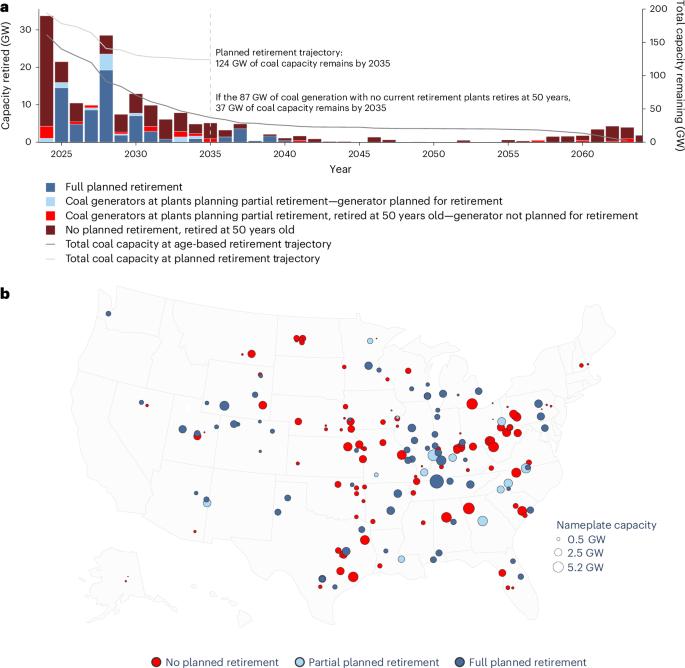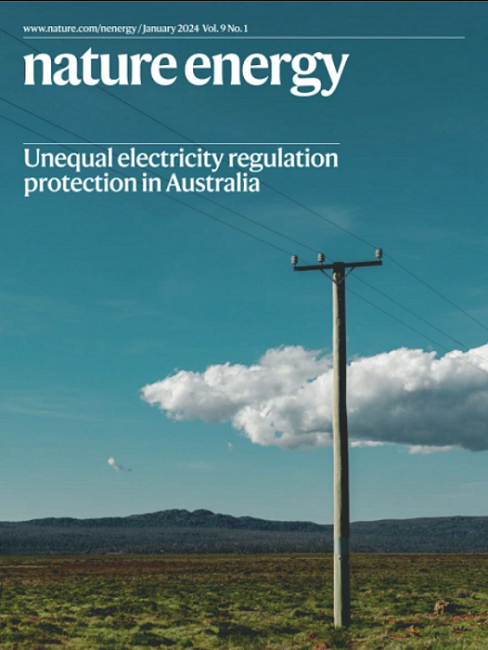利用情境退休脆弱性加速美国煤电淘汰的策略
IF 60.1
1区 材料科学
Q1 ENERGY & FUELS
引用次数: 0
摘要
从战略上规划逐步淘汰煤电对实现气候目标至关重要,但目前的方法往往未能考虑到具体情况下的障碍和淘汰的脆弱性。在这里,我们引入了一个结合图论和拓扑数据分析的框架,根据技术、经济、环境和社会政治特征,将美国煤炭船队分为八个不同的群体。我们计算了每个未退休的燃煤电厂的“情境退休脆弱性”得分,这是一个指标,用于量化对退休司机的敏感性,使用的是与宣布提前退休的燃煤电厂的基于图表的距离。另外,我们确定了“退休原型”,解释了每个群体中驱动宣布退休的关键因素,这些因素用于通知特定群体加速退休的策略。我们的研究结果揭示了加快淘汰剩余燃煤电厂所需的各种策略,包括遵守法规、开展公共卫生运动和采取经济激励措施。逐步淘汰煤炭需要有针对性的战略。新的研究基于与已宣布退役的电厂的相似性,评估了美国燃煤电厂的退役脆弱性。研究结果强调了指导和加速逐步淘汰的战略。本文章由计算机程序翻译,如有差异,请以英文原文为准。

Strategies to accelerate US coal power phase-out using contextual retirement vulnerabilities
Strategically planning the phase-out of coal power is critical to achieve climate targets, yet current approaches often fail to account for the context-specific barriers and vulnerabilities to retirement. Here we introduce a framework that combines graph theory and topological data analysis to classify the US coal fleet into eight distinct groups based on technical, economic, environmental and socio-political characteristics. We calculate each non-retiring coal plant’s ‘contextual retirement vulnerability’ score, a metric developed to quantify susceptibility to retirement drivers using the graph-based distance to a coal plant with an announced early retirement. Separately, we identify ‘retirement archetypes’ that explain the key factors driving announced retirements within each group, which are used to inform group-specific strategies for accelerating retirements. Our findings reveal the diverse strategies that are required to accelerate the phase-out of remaining coal plants, including regulatory compliance, public health campaigns and economic incentives. The phase-out of coal will require targeted strategies. New research assesses the retirement vulnerability of coal plants in the USA based on similarity to plants with announced retirements. The findings highlight strategies to guide and accelerate phase-out.
求助全文
通过发布文献求助,成功后即可免费获取论文全文。
去求助
来源期刊

Nature Energy
Energy-Energy Engineering and Power Technology
CiteScore
75.10
自引率
1.10%
发文量
193
期刊介绍:
Nature Energy is a monthly, online-only journal committed to showcasing the most impactful research on energy, covering everything from its generation and distribution to the societal implications of energy technologies and policies.
With a focus on exploring all facets of the ongoing energy discourse, Nature Energy delves into topics such as energy generation, storage, distribution, management, and the societal impacts of energy technologies and policies. Emphasizing studies that push the boundaries of knowledge and contribute to the development of next-generation solutions, the journal serves as a platform for the exchange of ideas among stakeholders at the forefront of the energy sector.
Maintaining the hallmark standards of the Nature brand, Nature Energy boasts a dedicated team of professional editors, a rigorous peer-review process, meticulous copy-editing and production, rapid publication times, and editorial independence.
In addition to original research articles, Nature Energy also publishes a range of content types, including Comments, Perspectives, Reviews, News & Views, Features, and Correspondence, covering a diverse array of disciplines relevant to the field of energy.
 求助内容:
求助内容: 应助结果提醒方式:
应助结果提醒方式:


